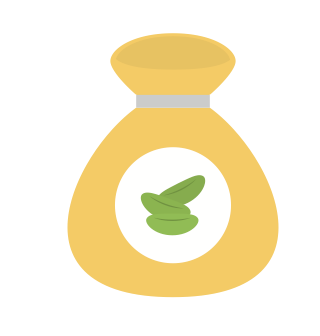Sage
Sage has large, soft, resinous leaves with a deep aroma. A little goes a long way when seasoning dishes and its pine-like flavor tastes great in a stuffing or soup.
VARIETIES
There are three main categories of sage:
Culinary, or common, is best used for cooking because it has the most essential oils and flavor;
Ornamental, typically used to attract pollinators like butterflies and hummingbirds, is also edible and its flowers make a nice tea or garnish, and;
Tricolor sage, which has the same great taste of culinary sage but with a splash of color on the leaves. You can substitute tricolor sage varieties in recipes that call for common sage.
WHERE SAGE THRIVES
Regional compatibility
Sage grows best in dry climates but can be grown nearly anywhere. In very cold winter climates add a layer of mulch to your sage after the first frost to help it survive the winter.
Optimal shade & sun
For the best flavor, sage should receive full sunlight.
RESILIENCE
Adaptability to climate extremes. Sage does better in dry, hot climate extremes than it does in cold, wet extremes. If you live in an especially cold and rainy region make sure that your dirt is sandy and drains well. Adding pebbles to your mulch is one way to keep your soil well-drained.
Drought resistance. Sage is extremely drought resistant.
PREP YOUR SOIL
Optimal type of soil. Sage grows best in a sandy loam soil. Good drainage is essential if you plan to keep your sage over the winter. If not, sage can handle almost any soil type as long as it contains enough nitrogen. The best time to add nitrogen to the soil is when you plant it. Shake in some low-nitrogen fertilizer before you add the plant.
PLANTING
Sage can be hard to grow from seed and plants can take up to 2 years to reach maturity. If you do grow from seed, sprinkle 3-4 small seeds per pot onto the soil surface and gently pat into the growing medium. Be patient as seeds can take up to 3 weeks to germinate. If you want to speed things up, consider starting your seeds on a heat mat set at 80 degrees. Thin to one plant per pot after germination. It’s probably easier to grab a few cuttings or buy a plant from a store. Roots will emerge from cuttings within approximately six weeks. After root balls form, transfer the sage to your garden and plant them two to three feet apart.
Best time of year to plant
Plant sage seeds 8 weeks before the last frost, which varies by region. If you are planting cuttings, plant outside was the danger of frost has passed.
Companion PLants
When it flowers, sage attracts pollinators, like bees, that benefit neighboring plants. So go ahead and pair sage with beans, rosemary, strawberries, or tomatoes. Sage also protects cabbage and carrots from flying pests. Avoid planting sage with cucumbers.
Growing
Sage grows in a round, bushy pattern. Prune mature sage plants before spring or after its summer flowers bloom to promote new growth.
WaterinG
Allow the soil around your sage to dry out in between thorough waterings. If leaves look a little shrunken or wilted, don’t fret – a little water can perk sage right up.
Mulching
Mulch helps sage survive cold winters. You can mulch with pebbles or gravel to keep the soil drier, which is the ideal condition for sage.
Fertilizing
Overfertilizing can produce an abundant sage plant with little flavor. For best results, use a low-nitrogen fertilizer at the time you plant the sage, and only then.
CHALLENGES
pests
Aphids, slugs, and caterpillars can be a problem for sage.
Diseases
Sage is susceptible to mildew so avoid over-watering. Also don’t water the actual plant. Just water the soil so you limit the chance moisture will collect on leaves.
Particular growing challenges
Most experts recommend you consider replacing sage plants every 4 to 5 years because with age they can become woody and stop branching. Woody plants do not produce the essential oils that give sage its flavor.
HARVEST
Pick sage leaves lightly in the first year of growth. You can cut stems or simply remove leaves individually. The new leaves at the top of the plant have the most flavor.
STORE
Store in a container in the refrigerator for short-term use. You can also leave cuttings in water on the counter.
Preserve
Hang sage bunches upside down to dry them














